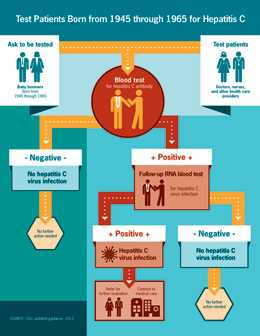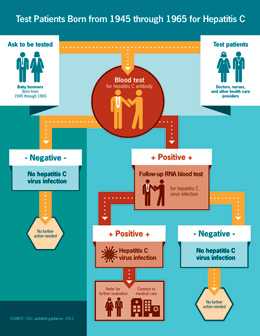Hepatitis C Testing Infographic
On this Page
From this page, you may download a high-resolution version of the full infographic or get the code for embedding the full infographic onto your organization’s website.
These high-resolution, public domain images are ready to be printed in your publication, or shared on your publication’s website.
These images are in the public domain and are thus free of any copyright restrictions. As a matter of courtesy, we request that the content provider be credited and notified of any public or private usage of an image.
Please note that this resource is for reporters. If you are a member of the general public and seek additional information about viral hepatitis, please visit http://www.cdc.gov/hepatitis/. If you have additional questions, please call 1(800) CDC INFO or contact CDC-INFO.
Hepatitis C Testing: Infographic
 Test Patients born from 1945 through 1965 for Hepatitis C
Test Patients born from 1945 through 1965 for Hepatitis C
Download High Resolution Version
Hepatitis C causes serious liver disease, even liver cancer. Blood tests are needed to tell if you have hepatitis C. A screening blood test, called an antibody test, shows if a person has ever been infected with the hepatitis C virus. If the antibody test is positive, a follow-up RNA blood test is needed to see if a person is still infected with the hepatitis C virus.
Anyone can get hepatitis C, but adults born from 1945 through 1965 are 5 times more likely to have hepatitis C. CDC recommends that everyone in the U.S. born from 1945 through 1965 be tested for hepatitis C in order to increase the proportion of those who know they are infected and linked to care. CDC also recommends that other populations at increased risk for hepatitis C get tested.
Infographic – Printable PDF
- Page last reviewed: May 7, 2013
- Page last updated: December 27, 2013
- Content source:


 ShareCompartir
ShareCompartir


